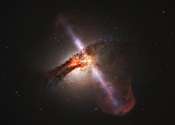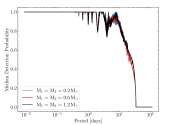Last update:
Astronomy news

Hubble measures the distance to a supernova
Measuring the distance to truly remote objects like galaxies, quasars, and galaxy clusters is a crucial task in astrophysics, particularly when it comes to studying the early universe, but it's a difficult one to complete.
Astronomy
12 hours ago
0
35

Vivid portrait of interacting galaxies marks Webb's second anniversary
A duo of interacting galaxies commemorates the second science anniversary of NASA's James Webb Space Telescope, which takes constant observations, including images and highly detailed data known as spectra. Its operations ...
Astronomy
12 hours ago
0
18

How astronomers work out the size of the solar system
The size of the solar system is defined by the volume of space over which the sun's influence exceeds those of other nearby stars in the Milky Way galaxy. This influence derives from two fundamental forces of nature: gravity ...
Astronomy
13 hours ago
0
57

Hubble finds evidence for rare black hole in Omega Centauri
An international team of astronomers has used more than 500 images from the NASA/ESA Hubble Space Telescope spanning two decades to detect seven fast-moving stars in the innermost region of Omega Centauri, the largest and ...
Astronomy
15 hours ago
0
16

New research reveals how galaxies avoid early death
Galaxies avoid an early death because they have a "heart and lungs" which effectively regulate their "breathing" and prevent them from growing out of control, a new study suggests.
Astronomy
Jul 11, 2024
0
65

Q&A: Researcher discusses how gravitational waves hint at dark matter and Big Bang mysteries
Gravitational waves, ripples in space-time predicted by Einstein almost a century ago, were detected for the first time in 2015. A new study led by Yanou Cui, an associate professor of physics and astronomy at the University ...
Astronomy
Jul 11, 2024
1
219

Take a summer cosmic road trip through images from NASA's Chandra, Webb
It's time to take a cosmic road trip using light as the highway and visit four stunning destinations across space. The vehicles for this space get-away are NASA's Chandra X-ray Observatory and James Webb Space Telescope.
Astronomy
Jul 11, 2024
0
58

NASA's Hubble traces dark matter in dwarf galaxy using stellar motions
The qualities and behavior of dark matter, the invisible "glue" of the universe, continue to be shrouded in mystery. Though galaxies are mostly made of dark matter, understanding how it is distributed within a galaxy offers ...
Astronomy
Jul 11, 2024
0
89

JWST sheds light on the structure of interstellar water ice
Using the James Webb Space Telescope (JWST), a team of researchers including Paola Caselli, Barbara Michela Giuliano and Basile Husquinet from MPE, have probed deep into dense cloud cores, revealing details of interstellar ...
Astronomy
Jul 11, 2024
0
49

Nearest millisecond pulsar has radius of 11.4 kilometers and is 1.4x as heavy as the sun, researchers find
The nearest millisecond pulsar PSR J0437-4715 has a radius of 11.4 kilometers and a mass 1.4 times that of the sun. These are the results of precision measurements made by a team of researchers led by the University of Amsterdam ...
Astronomy
Jul 11, 2024
0
67

Astronomers apply machine learning techniques to find early-universe quasars in an ocean of data
Quasars are extremely luminous galactic cores where gas and dust falling into a central supermassive black hole emit enormous amounts of light. Due to their exceptional brightness, these objects can be seen at high redshifts, ...
Astronomy
Jul 11, 2024
0
21

Astronomers discover dozens of double-lined double white dwarf binaries
An international team of astronomers reports the discovery of 34 rare double-lined double white dwarf binary systems using the Intermediate-dispersion Spectrograph and Imaging System (ISIS) on the William Herschel Telescope ...

Deep-mapping the night sky for hot stars
The next NASA space telescope to survey the ultraviolet sky has the fingerprint of an astronomer from the Institute of Science and Technology Austria (ISTA). Assistant Professor Ylva Götberg is part of a large international ...
Astronomy
Jul 10, 2024
0
8

Astronomers find the nearest massive black hole, a missing link in massive black hole formation
Newly identified fast-moving stars in the star cluster Omega Centauri provide solid evidence for a central black hole in the cluster. With at least 8,200 solar masses, it is the best candidate for a class of black holes astronomers ...
Astronomy
Jul 10, 2024
2
228

Researchers more precisely calculate how much faster time passes on the moon
A team of physicists with NASA's Jet Propulsion Laboratory at the California Institute of Technology has calculated more precisely how much faster time passes on the moon than on the Earth. The paper describing the math they ...

Study investigates the nature of very-high energy gamma-ray source TeV J2032+4130
Using the High-Altitude Water Cherenkov (HAWC) observatory, an international team of astronomers has observed a very-high energy gamma-ray source designated TeV J2032+4130. Results of the observational campaign, presented ...

XL-Calibur telescope launched to study black holes
Scientists from Washington University in St. Louis have launched a balloon-borne telescope to unlock the secrets of astrophysical black holes and neutron stars, some of the most extreme objects in the universe.
Astronomy
Jul 10, 2024
0
8

Building a prototype of the cosmos
How would it feel to peer into the night sky and behold millions of galaxies across a vast swath of space? What would it be like to hunt for worlds beyond our solar system, or spot the fiery deaths of stars?
Astronomy
Jul 9, 2024
0
18

A once-in-a-lifetime explosion is about to create a 'new' star in the sky
Any night now, a "new star" or nova will appear in the night sky. While it won't set the sky ablaze, it's a special opportunity to see a rare event that's usually difficult to predict in advance.
Astronomy
Jul 9, 2024
0
59

We need to consider alternatives to dark matter that better explain cosmological observations
Do constants of nature—the numbers that determine how things behave, like the speed of light—change over time as the universe expands? Does light get a little tired traveling vast cosmic distances? It was believed that ...
Astronomy
Jul 9, 2024
40
66
Other news

How to make an old antibiotic 100 times more potent


























































